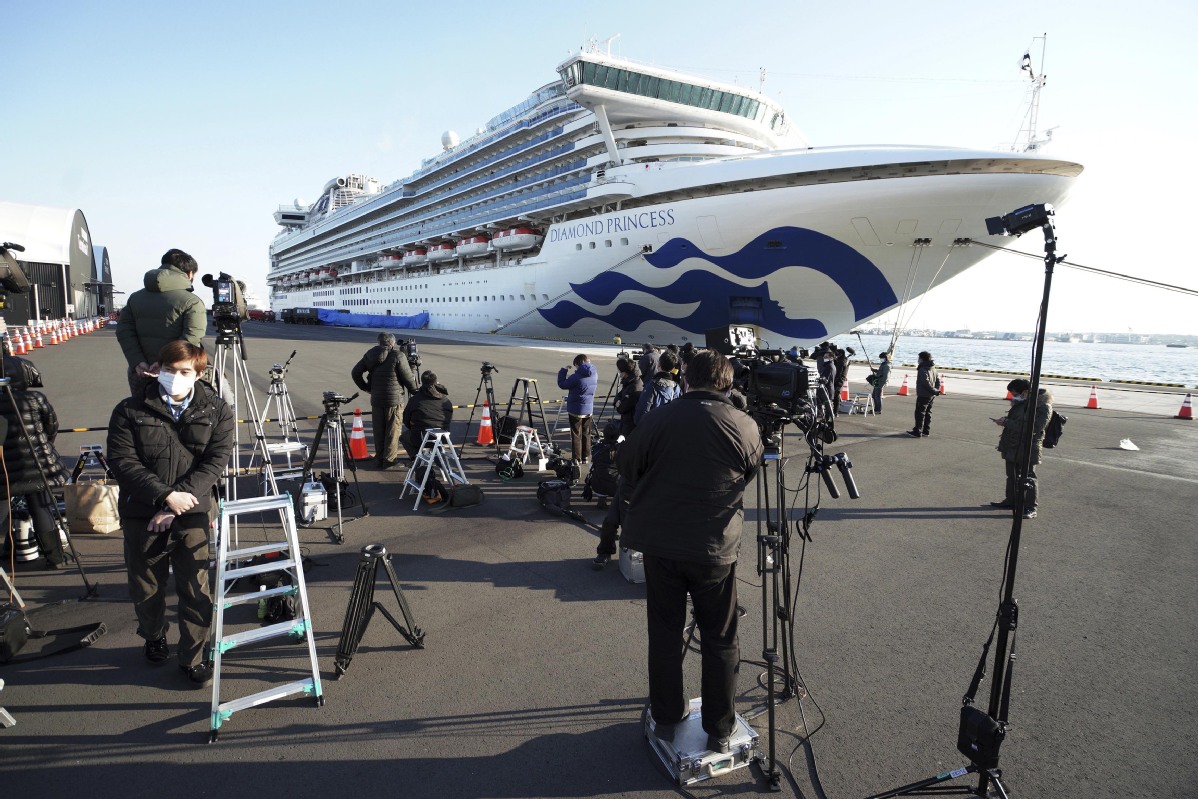Cruise ship ordeal deepens safety fears
By WANG XU in Tokyo | CHINA DAILY | Updated: 2020-02-12 07:37

As fate of quarantined passengers and crew debated, 39 more cases confirmed
As experts debate what to do with the 3,700 or so people quarantined on a cruise ship in the port of Yokohama, 39 more passengers tested positive for the coronavirus on Wednesday.
The additions bring the total number of infections on board the ship to 174 as well as one quarantine officer. The fact that crew members who live and work below decks toil elbow-to-elbow raises the likelihood that further infections will be detected.
Against the backdrop of the rising tally of infections, medical experts in Japan have been weighing up whether the passengers and crew in quarantine should be kept for longer on the ship or taken ashore.
Wednesday marked the nineth day that the Diamond Princess has been quarantined, yet the risks to all on board the ship were reinforced when Japan's health ministry confirmed the 39 additional cases. The latest to test positive to the virus include 10 crew members, 10 Japanese nationals and the others from 11 countries including the United States and China. Four were in serious condition.
"Very soon we will all be infected," said Binay Kumar Sarkar, an Indian crew member who posted a video on Facebook imploring Indian Prime Minister Narendra Modi for assistance. "Everyone is scared who will be next."
Sarkar is among the more than 1,000 crew members who have to live and work preparing the passengers' dishes and traversing the ship to deliver them. Unlike the more than 2500 passengers who are carefully isolated in their cabins with their meals delivered and are allowed to walk on deck for a few minutes a day, the crew live as many as four to a room and have to eat buffet-style meals together.
At least 10 crew members have tested positive for the virus earlier, with five cases announced on Sunday and five more on Monday. Experts warn this could just be the start, because the workers have more contact with other people, increasing their chances of infection.
According to local media reports, the infected crew members identified have been eating in the mess hall alongside their colleagues.
It is not clear yet that how many people on the ship have the coronavirus because the health ministry said on Monday that so far it had tested just 439 people. That leaves more than 3,000 others receiving only initial health checks.
On Monday, Health Minister Katsunobu Kato said that the ministry was looking into the feasibility of testing everyone, to ensure they do not spread the virus around Japan or elsewhere. But that would require the passengers and crew to remain on board until the results were available.
Chief Cabinet Secretary Yoshihide Suga said that, under the circumstances, testing everyone would be "difficult".
Experts have begun questioning the soundness of the quarantine strategy, which initially determined that the confinement remain in place until Feb 19. They have called for urgent action backed by a new plan.
"It appears that there is an ongoing risk of transmission on the ship and we're now exposing healthy people to people who have the disease," Tom Inglesby, director of the Hopkins Center for Health Security of the United States, was quoted by The Washington Post as saying.
"This approach is no longer effective in ending the spread, or interrupting the spread."
In response, the Japanese government plans to allow the elderly and those with chronic illnesses to disembark the ship soon, Kyodo News reported, citing unidentified sources.
In Japan, the number of people infected by the coronavirus hit 203 on Wednesday, including the 174 from the cruise ship and the quarantine officer. Twelve cases were sourced from charter flights and 16 tourists tested positive.
In a country with the most cases of coronavirus outside China, members of Japan's ruling Liberal Democratic Party in the Diet have expressed their wish to help.
On Monday, Toshihiro Nikai, the general secretary of the LDP, said that all party members will each donate 5,000 yen ($46) to China for use in battling the outbreak.
"It's natural to help a neighboring country if something happens there," Nikai said.
























